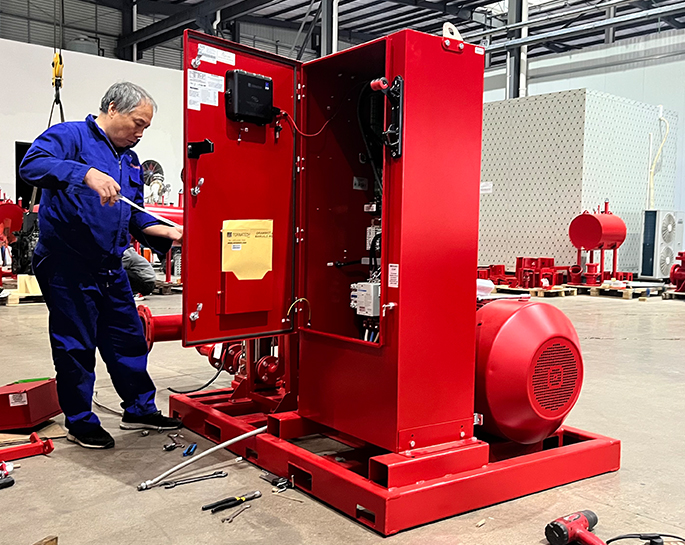Precautions when using fire pumps
Dec 11, 2023
Share:
Using fire pumps involves handling equipment designed for emergency situations. To ensure safety and effectiveness, it's important to follow specific precautions when using fire pumps. Here are some general guidelines:
1. **Training and Familiarity:**
- Ensure that personnel using the fire pump are adequately trained in its operation and maintenance.
- Regularly conduct training drills to keep users familiar with the equipment.
2. **Read the Manual:**
- Thoroughly read and understand the manufacturer's manual for the specific fire pump model you are using.
- Follow the recommended procedures for startup, operation, and shutdown.
3. **Inspection and Maintenance:**
- Regularly inspect the fire pump and associated components for any signs of damage, wear, or corrosion.
- Perform routine maintenance as recommended by the manufacturer.
4. **Proper Installation:**
- Install the fire pump in accordance with the manufacturer's specifications and guidelines.
- Ensure proper grounding and electrical connections.
5. **Power Source:**
- Verify that the power source for the fire pump is reliable and meets the specified requirements.
- Check the condition of power cables and connections.
6. **Fuel Supply:**
- If the fire pump is powered by fuel, ensure an adequate and clean fuel supply.
- Regularly check fuel levels and perform maintenance on fuel systems.
7. **Water Supply:**
- Verify that the water supply is sufficient and meets the pump's requirements.
- Keep the intake free from debris and ensure proper filtration.
8. **Pressure Relief Valve:**
- Ensure that the fire pump is equipped with a pressure relief valve to prevent over-pressurization.
- Regularly test and maintain the pressure relief valve.
9. **Monitoring:**
- Monitor pump performance and pressure levels during operation.
- Keep an eye on temperature gauges to prevent overheating.
10. **Emergency Stop Procedures:**
- Ensure that all users are familiar with emergency stop procedures.
- Test the emergency stop mechanism regularly.
11. **Weather Considerations:**
- Take weather conditions into account, especially in outdoor installations.
- Protect the pump from extreme temperatures, and ensure it is shielded from adverse weather conditions.
12. **Record Keeping:**
- Maintain a log of inspections, maintenance activities, and any issues encountered.
- Keep records of testing and training sessions.
13. **Compliance with Standards:**
- Ensure that the fire pump and its installation comply with relevant safety standards and regulations.
14. **Contact Authorities:**
- Coordinate with local authorities and fire departments regarding the use of fire pumps and emergency response procedures.
By following these precautions, you can help ensure the reliability and safety of fire pumps when they are needed in emergency situations. Always prioritize the well-being of personnel and property during fire pump operations.

1. **Training and Familiarity:**
- Ensure that personnel using the fire pump are adequately trained in its operation and maintenance.
- Regularly conduct training drills to keep users familiar with the equipment.
2. **Read the Manual:**
- Thoroughly read and understand the manufacturer's manual for the specific fire pump model you are using.
- Follow the recommended procedures for startup, operation, and shutdown.
3. **Inspection and Maintenance:**
- Regularly inspect the fire pump and associated components for any signs of damage, wear, or corrosion.
- Perform routine maintenance as recommended by the manufacturer.
4. **Proper Installation:**
- Install the fire pump in accordance with the manufacturer's specifications and guidelines.
- Ensure proper grounding and electrical connections.
5. **Power Source:**
- Verify that the power source for the fire pump is reliable and meets the specified requirements.
- Check the condition of power cables and connections.
6. **Fuel Supply:**
- If the fire pump is powered by fuel, ensure an adequate and clean fuel supply.
- Regularly check fuel levels and perform maintenance on fuel systems.
7. **Water Supply:**
- Verify that the water supply is sufficient and meets the pump's requirements.
- Keep the intake free from debris and ensure proper filtration.
8. **Pressure Relief Valve:**
- Ensure that the fire pump is equipped with a pressure relief valve to prevent over-pressurization.
- Regularly test and maintain the pressure relief valve.
9. **Monitoring:**
- Monitor pump performance and pressure levels during operation.
- Keep an eye on temperature gauges to prevent overheating.
10. **Emergency Stop Procedures:**
- Ensure that all users are familiar with emergency stop procedures.
- Test the emergency stop mechanism regularly.
11. **Weather Considerations:**
- Take weather conditions into account, especially in outdoor installations.
- Protect the pump from extreme temperatures, and ensure it is shielded from adverse weather conditions.
12. **Record Keeping:**
- Maintain a log of inspections, maintenance activities, and any issues encountered.
- Keep records of testing and training sessions.
13. **Compliance with Standards:**
- Ensure that the fire pump and its installation comply with relevant safety standards and regulations.
14. **Contact Authorities:**
- Coordinate with local authorities and fire departments regarding the use of fire pumps and emergency response procedures.
By following these precautions, you can help ensure the reliability and safety of fire pumps when they are needed in emergency situations. Always prioritize the well-being of personnel and property during fire pump operations.


.png)
.png)

.png)


